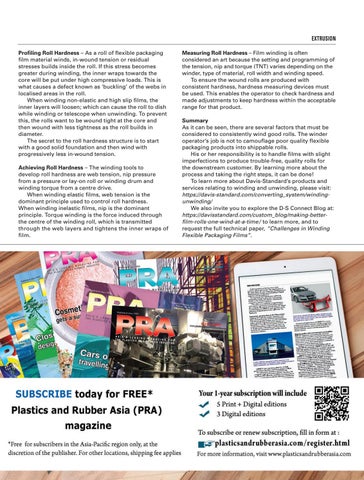Extrusion Profiling Roll Hardness – As a roll of flexible packaging film material winds, in-wound tension or residual stresses builds inside the roll. If this stress becomes greater during winding, the inner wraps towards the core will be put under high compressive loads. This is what causes a defect known as ‘buckling’ of the webs in localised areas in the roll. When winding non-elastic and high slip films, the inner layers will loosen; which can cause the roll to dish while winding or telescope when unwinding. To prevent this, the rolls want to be wound tight at the core and then wound with less tightness as the roll builds in diameter. The secret to the roll hardness structure is to start with a good solid foundation and then wind with progressively less in-wound tension. Achieving Roll Hardness – The winding tools to develop roll hardness are web tension, nip pressure from a pressure or lay-on roll or winding drum and winding torque from a centre drive. When winding elastic films, web tension is the dominant principle used to control roll hardness. When winding inelastic films, nip is the dominant principle. Torque winding is the force induced through the centre of the winding roll, which is transmitted through the web layers and tightens the inner wraps of film.
Measuring Roll Hardness – Film winding is often considered an art because the setting and programming of the tension, nip and torque (TNT) varies depending on the winder, type of material, roll width and winding speed. To ensure the wound rolls are produced with consistent hardness, hardness measuring devices must be used. This enables the operator to check hardness and made adjustments to keep hardness within the acceptable range for that product. Summary As it can be seen, there are several factors that must be considered to consistently wind good rolls. The winder operator’s job is not to camouflage poor quality flexible packaging products into shippable rolls. His or her responsibility is to handle films with slight imperfections to produce trouble-free, quality rolls for the downstream customer. By learning more about the process and taking the right steps, it can be done! To learn more about Davis-Standard’s products and services relating to winding and unwinding, please visit: https://davis-standard.com/converting_system/windingunwinding/ We also invite you to explore the D-S Connect Blog at: https://davisstandard.com/custom_blog/making-betterfilm-rolls-one-wind-at-a-time / to learn more, and to request the full technical paper, “Challenges in Winding Flexible Packaging Films”.
